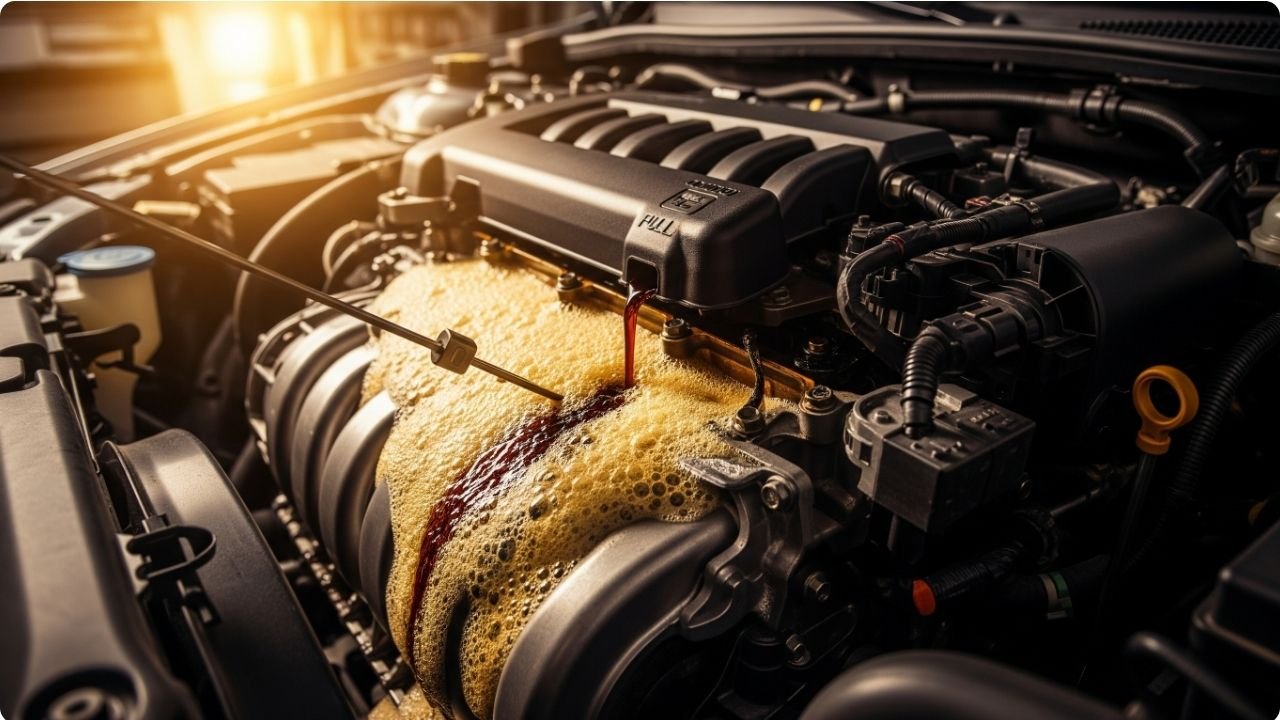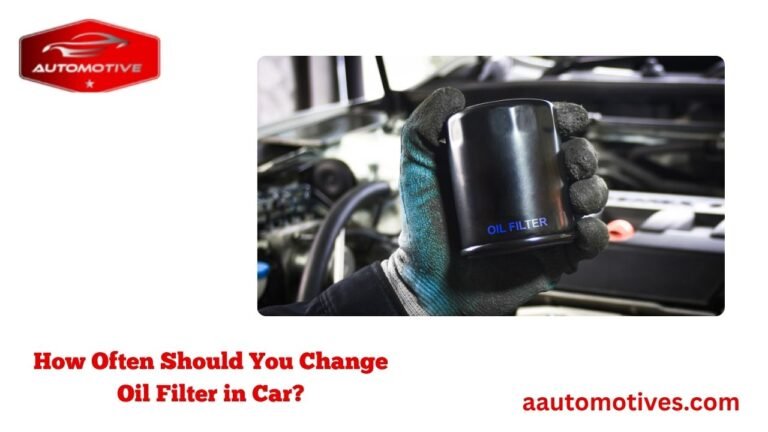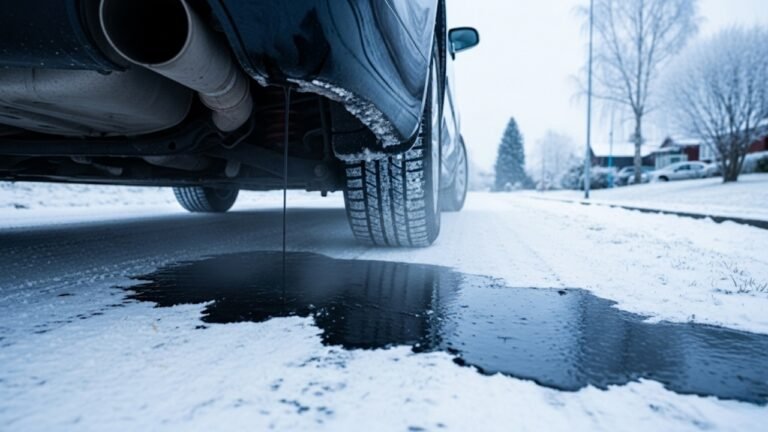What Happens If You Overfill Oil in Car? A Friendly Guide

Ever thought more oil means better engine performance? I did once. And guess what? It backfired—literally.
Overfilling oil in your car feels harmless. After all, oil keeps everything running smooth, right? But like adding too much salt to your favorite curry, too much engine oil can ruin everything. I learned this the hard way during a road trip to Sylhet. Instead of cruising through green hills, I was stuck on the roadside, engine smoking, wallet hurting.
In this guide, we’ll explore what happens if you overfill oil in car, why it matters, and how to handle it if you do. I’ll mix technical facts with personal stories, so it’s both helpful and human.
Let’s dive in.
The Heart of the Engine: Why Oil Is So Important
Oil isn’t just a slippery liquid. It’s the lifeblood of your engine. Like our own blood delivers oxygen, engine oil carries lubrication, heat reduction, and cleaning power to your car’s internal parts.
But oil has to be at the right level. Not too little. Not too much. Imagine drinking water—you need enough to stay hydrated, but too much can cause water intoxication. Same thing here.
Proper oil levels:
- Keep engine parts from grinding together.
- Carry away heat.
- Trap and move debris to the oil filter.
- Help fuel efficiency and reduce wear.
So when we overfill the engine oil, we disrupt this balance. And what follows isn’t pretty.
Overfilling Oil: What Really Happens Inside the Engine?
So, what happens if you overfill oil in car? When there’s too much oil, the crankshaft ends up churning it like a blender. This causes foaming, and foamy oil doesn’t lubricate well.
Effects of Overfilled Oil:
- Increased pressure inside the engine.
- Oil can reach areas it shouldn’t, like spark plugs.
- Damage to gaskets and seals.
- Catalytic converter failure.
- Risk of hydro-locking the engine (when oil floods combustion chambers).
- Smoke from the tailpipe.
Let me break it down further in a table for clarity:
| Consequence | Description |
|---|---|
| Oil Foaming | Oil bubbles don’t lubricate properly. |
| Seal Damage | Pressure may burst seals and cause leaks. |
| Smoke and Smell | Burning oil smells and visible smoke from the exhaust. |
| Engine Misfire | Oil on spark plugs causes incomplete combustion. |
| Poor Fuel Economy | Engine works harder, burning more fuel. |
| Engine Damage | Severe overfill can ruin pistons and bearings. |
Now imagine being on a long drive and suddenly seeing smoke. That’s what happened to me. I’d overfilled the oil just before heading out. Thought I was being smart—turns out I was being reckless.
Symptoms That Your Car Has Too Much Oil
Your car will tell you if something’s wrong. You just have to listen. I missed the signs once. Never again.
Here’s what to watch for if you’ve accidentally poured in too much oil:
Warning Signs:
- White smoke from the exhaust.
- Burning oil smell.
- Check engine light or oil light flickering.
- Engine feels sluggish.
- Rough idling or stalling.
- Oil leaks under the car.
These signs often show up within minutes to hours of overfilling. It may not happen right away. But damage builds fast if you keep driving. The sooner you fix it, the better.
Real-Life Story: How I Ruined My Day (And Almost My Engine)
One time, I was in a rush before a wedding. Changed the oil myself. Wasn’t paying full attention—ended up adding almost a liter too much.
Drove off. Thirty minutes later, the engine sputtered. White smoke. Panic. Pulled over near a tea stall. Locals came to help. One of them, a mechanic’s apprentice, pointed out that the oil was well above the max mark.
I had to call a mobile mechanic to drain the excess oil on the roadside. Cost me time, money, and pride.
Lesson learned: even small overfills matter. Always check that dipstick after the pour.
How Much Oil Is Too Much?
Now, here’s where people often get confused. A small overfill (a few millimeters above the max line) might not cause immediate harm. But if you’ve added more than half a quart (about 500 ml) extra, you’re likely headed for trouble.
Here’s a simple way to know:
Dipstick Reading Guide:
- Below Min Line → Too little. Top up needed.
- Between Min and Max → Perfect.
- Slightly above Max → Monitor carefully.
- Far above Max → Drain oil ASAP.
It’s easy to check. Wipe the dipstick clean, insert it fully, then remove and read. If the oil looks way too high, don’t start the engine.
Can You Drive with Too Much Oil?
Technically, yes—for a short while. But should you? Absolutely not.
If you’re in a desperate situation, and the excess is very minor, you might get away with driving a few kilometers to a workshop. But anything more, and the risks multiply.
Your catalytic converter, which helps reduce emissions, can get clogged with burning oil. Once that fails, you’re not only looking at engine damage—you’ll be polluting more and may fail inspections.
In short: Don’t gamble with your engine’s life. It’s not worth it.
What To Do If You’ve Overfilled Oil in Car
So you’ve added too much oil. Now what?
Step-by-step fix:
- Turn off the engine immediately.
- Let it cool down if recently driven.
- Check the dipstick to see how high the oil is.
- Drain excess oil using one of these:
- Oil extractor pump (clean and easy).
- Loosen the drain plug carefully and let some out.
- Check oil level again.
- Restart the engine and observe.
- Watch for smoke, smells, or warning lights.
If you’re not comfortable doing it yourself, tow your car to a trusted mechanic. It’s cheaper than a new engine.
Long-Term Effects of Driving with Too Much Oil
Driving with overfilled oil might not seem like a big deal at first. But the long-term effects can sneak up on you like rust on metal—slow, silent, and destructive.
Here’s what might happen over time:
- Worn-out piston rings due to oil burning inside the combustion chamber.
- Clogged catalytic converter, which can cost hundreds to replace.
- Damaged gaskets and seals, causing leaks that lead to even bigger issues.
- Gradual power loss and reduced mileage.
- Engine overheating, even in cool weather.
I’ve met drivers who said, “Oh, I drove with extra oil for months—nothing happened.” Maybe they got lucky. Or maybe their engine is quietly wearing out faster than they realize.
It’s like eating too much sugar daily—your body may not scream right away, but diabetes doesn’t care about your denial.
Preventing Oil Overfill: Simple Habits That Save You Headaches
Let’s not wait for trouble to knock. Here are some easy steps to prevent overfilling your car’s oil in the first place.
Golden Rules:
- Read your owner’s manual: Know the exact oil capacity.
- Use the dipstick after each pour: Even if it seems perfect, always double-check.
- Add oil in small amounts, especially if topping up.
- If you’re doing an oil change yourself, pre-measure the correct amount before pouring.
- Check oil level after the engine has been off for 5–10 minutes for accurate results.
When I started changing my own oil, I used to guess. But after one costly mistake, I now use a marked container and pour carefully. It’s a small habit, but it keeps my engine happy—and my wallet safer.
Expert Insight: What Mechanics Say About Overfilling
I had a chat with my friend Riaz, a certified mechanic in Dhaka, and here’s what he said:
“We get cars every week with engine problems because people think more oil means better performance. It’s a myth. Excess oil creates pressure, and pressure breaks things. Simple.”
He also mentioned that modern engines are more sensitive. Their tolerances are tight. Even a small excess can mess with oil flow sensors or timing mechanisms.
Another expert tip: If your car has a turbocharger, the risks double. Excess oil can enter the turbo system and cause severe, smoky damage.
Moral of the story? Respect the dipstick. It’s not just a piece of metal—it’s a lifeline.
Is Overfilling Oil Ever Okay? Let’s Be Honest
Sometimes, we try to justify mistakes. Maybe you think, “Just a little over. It’ll be fine.”
Here’s the truth:
- Slightly above max line? Maybe you’re okay.
- 1+ cm above? You’re not.
- Oil puddling on top of dipstick? You’re asking for trouble.
It’s okay to make mistakes—we all do. But learn fast, and act faster. The cost of fixing engine damage is far greater than the effort it takes to drain a bit of oil.
FAQs: Everything You Wanted to Know But Didn’t Ask
1. Can overfilled oil cause smoke from the exhaust?
Yes. Extra oil gets into the combustion chamber and burns, creating white or blue smoke.
2. Will the check engine light come on if there’s too much oil?
It can. Especially if sensors detect misfires, pressure changes, or fouled plugs.
3. Can too much oil cause engine misfire?
Absolutely. Oil can coat spark plugs, disrupting ignition and causing rough idling or misfires.
4. Is it safe to drain oil from the dipstick tube?
Yes, if you have an oil extractor pump. It’s cleaner and safer for small corrections.
5. How much oil overfill is harmful?
Generally, more than 0.5 liters (500 ml) over the full mark is risky.
6. Can a mechanic fix this fast?
Yes. Most shops can drain and reset oil levels in under 30 minutes.
7. Does driving style affect the impact of overfilling?
Yes. High RPMs and long drives worsen the risks. City driving may delay damage, but not prevent it.
8. Can overfilled oil damage the catalytic converter?
Yes. Burned oil releases particles that clog and poison your catalytic converter.
Wrapping It All Up: Respect the Dipstick
So, what happens if you overfill oil in car? A lot—and none of it is good. You risk foam, smoke, leaks, and even full-blown engine death. But with awareness, a steady hand, and a bit of discipline, it’s easy to avoid.
Remember my road trip mistake? That one blunder cost me hours and money—but it also taught me to trust the science, not assumptions.
Keep your oil levels just right. Don’t rush. Respect your car, and it’ll respect you back.
Final Thoughts: Drive Smart, Stay Simple
We live in a world of “more is better.” But when it comes to engine oil, more can mean destruction.
Use this guide as a gentle reminder from a fellow car lover who’s been there, messed up, and learned. It’s okay to make mistakes—but let’s not repeat them.
Stay safe, drive smooth, and next time you check your oil, think of this story.






